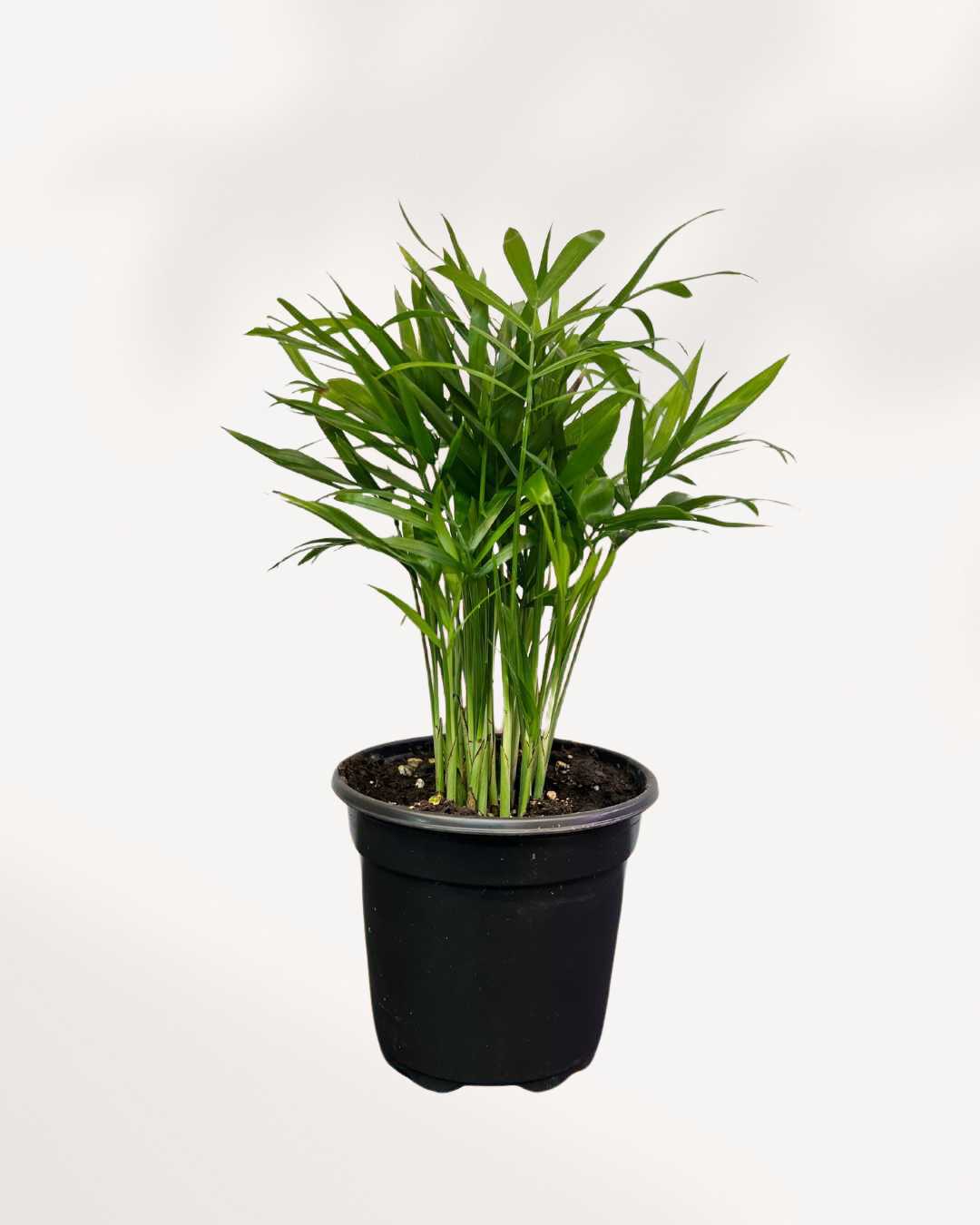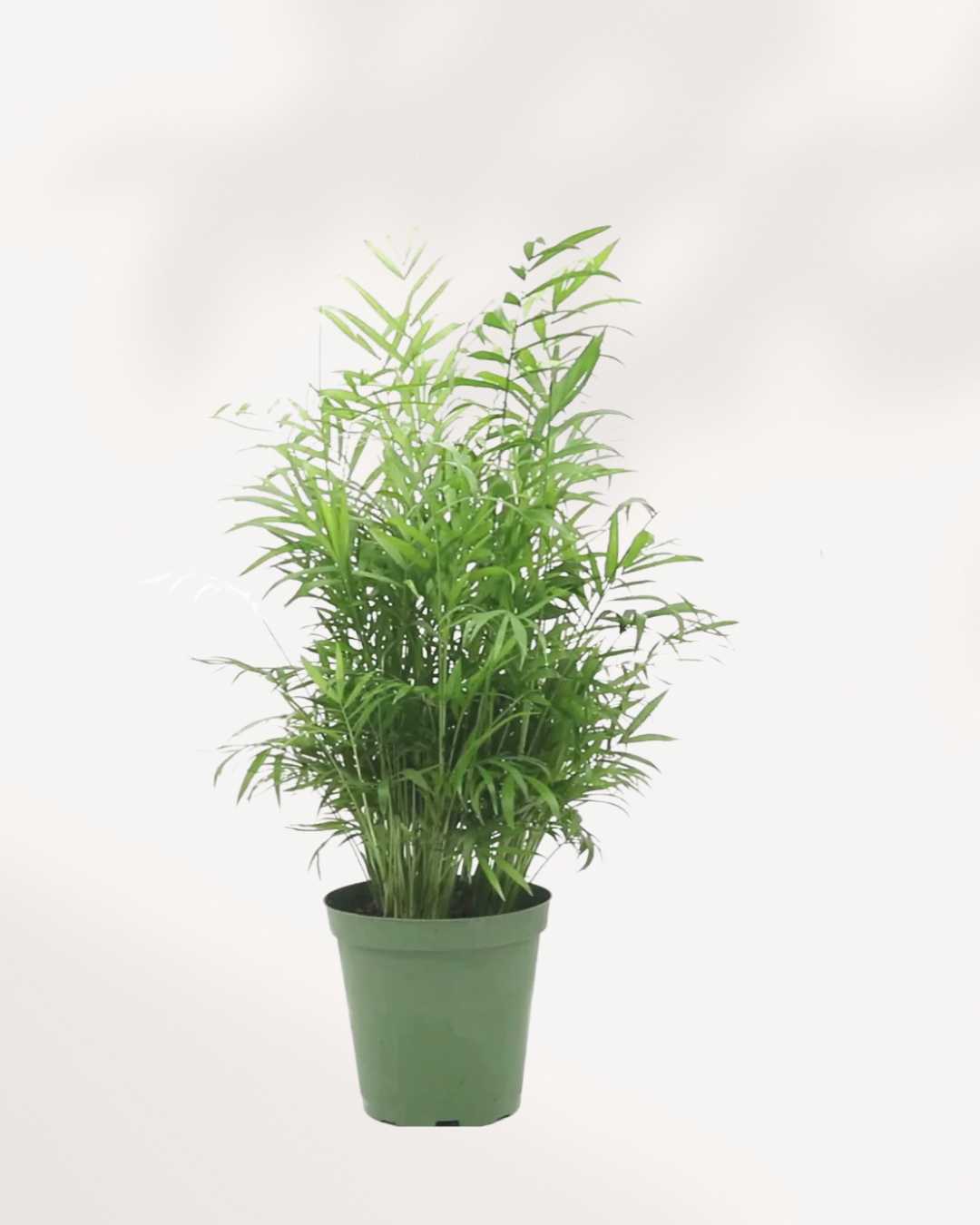Couldn't load pickup availability
Parlour Palm – Timeless Elegance in a Pet-Friendly Package
The Parlour Palm (Chamaedorea elegans) is a graceful, air-purifying indoor palm with feathery, arching fronds. Beloved since the Victorian era, it adds soft greenery to modern spaces and is a perfect, non-toxic choice for pet owners.
Why You'll Love Parlour Palm
- 🌿 Pet-friendly and non-toxic – safe for cats and dogs
- 🌤️ Thrives in low to moderate light – ideal for any room
- 💨 Naturally purifies indoor air
- 🪴 Requires little maintenance, perfect for plant beginners
Common Names
- Parlour Palm
- Neanthe Bella Palm
- Chamaedorea Elegans
Botanical Classification
- Kingdom: Plantae
- Order: Arecales
- Family: Arecaceae
- Genus: Chamaedorea
- Species: Chamaedorea elegans
Where It Comes From
Native to the rainforests of Mexico and Guatemala, the Parlour Palm naturally grows under dense canopies, making it perfectly suited to indoor environments with indirect or filtered light.
A Victorian Favorite
The Parlour Palm gained widespread popularity in the Victorian era when it graced the drawing rooms (parlours) of high society. Its continued popularity is a testament to its classic beauty and adaptable nature.
Why It’s So Popular
- Soft, feathery fronds create a peaceful, elegant vibe
- Low-light tolerance makes it great for apartments and offices
- Safe for pets – no worries for your furry friends
- Perfect for plant lovers at any experience level
What Does It Look Like?
Appearance
The Parlour Palm features slender, cane-like stems topped with delicate, arching green fronds. It grows upright with a bushy form, bringing texture and softness to any corner.
Growth Habit
Slow-growing and compact, this palm typically reaches 2–4 feet in height indoors. It's perfect for tabletop planters or as a floor plant in tight spaces.
Popular Plant Varieties
Philodendron Brasil
- Features vibrant green and yellow variegated leaves, perfect for bright indoor spaces.
Calathea Freddie
- Known for its striking striped leaves and tolerance to low light conditions.
Aglaonema Red Army
- Celebrated for its bold red veins and lush green foliage, ideal for low-light areas.
Peperomia Mini Watermelon
- Compact and pet-friendly plant with unique watermelon-like patterned leaves.
Pothos Golden
- Popular for its trailing growth and vibrant golden-green leaves, easy to maintain.
Dealing with Pests
Spider Mites
These pests thrive in dry air and can cause stippling on fronds. Mist your plant regularly and use neem oil to control them. Learn More
Mealybugs
Look for white, cottony patches on stems or leaves. Wipe them with alcohol-dipped cotton swabs and apply insecticidal soap. Learn More
Fungus Gnats
Overwatering can attract gnats. Let soil dry between waterings and use sticky traps to reduce their numbers. Learn More
Frequently Asked Questions
Is Parlour Palm safe for pets?
Yes, Parlour Palm is non-toxic to cats and dogs.
How much light does it need?
It prefers bright, indirect light but also grows well in low-light conditions.
How often should I water it?
Water when the top inch of soil feels dry. Do not let the plant sit in water.
Does it need pruning?
Minimal pruning is needed. Remove any brown or yellow fronds at the base.
How big will it grow?
Indoors, it typically reaches 2–4 feet tall. It grows slowly and remains compact.
Learn More About Parlour Palm Care
For in-depth care instructions and troubleshooting tips, visit our Palm Plant Care Guide.
Ready to Add Classic Green Elegance to Your Space?
Get your Parlour Palm today and enjoy lush greenery with minimal care.
Shop NowHow to take care of Parlour Palm
Sun: Indirect
Sun: Indirect
Light: Medium - Bright
Light: Medium - Bright
Water: When half dry
Water: When half dry
Humidity: Any
Humidity: Any
Yes! The Parlour Palm is non-toxic to cats, dogs, and humans—great for pet-friendly homes.
Yes! The Parlour Palm is non-toxic to cats, dogs, and humans—great for pet-friendly homes.
Pro Tip
Pro Tip
Delivery Policy for Plant Condition
Delivery Policy for Plant Condition
"I have only received part of my order. What to do?
No worries if you've only got part of your order! Our plants come from different nurseries and might arrive in separate shipments, typically 1-2 days apart. It's all part of ensuring your green friends reach you in top-notch condition!
If you do not receive the remaining packages within 48 hours contact support at info@mygreenscape.ca
What is the Life Time Support?
Absolutely! Lifetime support means you can count on us whenever you have questions or uncertainties about your plant. Whether you're puzzled by its behavior or just want to ensure it's thriving, we're here for you. Connect with us on Instagram @mygreenscapeto or shoot us an email at support@mygreenscape.ca.
When it comes to our guarantee for plants shipped with standard or express, rest assured that we offer a 30-day happy healthy plant guarantee on all such shipments. This ensures that your plants are covered for 30 days after delivery, giving you peace of mind regarding their condition. If you have any concerns within this period, feel free to reach out to us for assistance.
For further details, please visit our Local Delivery, Store Pickup, Standard Shipping Guide Page.
What to expect
What to expect
Your plant will arrive in a standard nursery pot, typically 0.5" - 1" smaller than the stated size to seamlessly fit into your chosen decorative pot. Washable Paper Planter Bags are available for separate purchase.
Just like nature intended, each plant is unique, showcasing natural variations in size, shape, and characteristics. Our commitment is to deliver a plant that closely resembles the one featured on our website, matching your chosen size, and with the potential to thrive happily in your home.
Frequently Asked Questions
Frequently Asked Questions
Certainly! If you're pondering about ordering plants online, you're not alone. We've compiled the most frequently asked questions. Check out our FAQ section here for quick answers! Happy planting!
Plant & Pot Size Chart
Plant & Pot Size Chart
Choosing the right pot size for your plants can be a daunting task, especially if you're new to gardening. But fear not! Our pot sizes chart can help you find the perfect match for your plants, ensuring they have enough space to grow and thrive. With our guide, you'll be able to confidently choose the right pot size and plant variety for your gardening needs.
Plant Pot Size Guide.

| Extra Small | 7-10 cm | 2.5 - 3 inches |
| Small | 11-12 cm | 3.5 - 4 inches |
| Medium | 14-17 cm | 5 - 6 inches |
| Large | 19-21 cm | 8 - 10 inches |
| Extra Large | 24-27 cm | 12 - 14 inches |
All sizes are specified in product details.
Your Complete Guide to Pot Sizes: What Size Should You Choose?

When selecting a pot for your plant, it's important to find the right size. But with all the different options out there, how do you know which one is best? We're here to help!
MyGreenscape's pot sizes chart is a great resource for finding your perfect fit. Our easy-to-read chart takes out all the guesswork and helps you quickly choose the right size for your plant.
Smaller pots are best for seedlings or small plants just starting out. These tend to be shallow but wide, allowing enough room for the roots of the young plant but not too much where they get overcrowded. Medium-sized pots are ideal when your plant has grown from its infancy and is ready for more space. These are deeper and wider than small pots, so that it can accommodate larger root systems - making sure your plant gets enough nourishment while still giving it breathing room. Large pots are top choice if you have an established plant in need of lots of space - think trees and large shrubs! The spacious depth and width allow plenty of room for deep root systems without struggling for air or light.
No matter what size you choose, MyGreenscape has got you covered, with our pot sizes chart guaranteeing you find the perfect fit every time!
Winter Shipping Protection
Winter Shipping Protection
We take extra care with each package during the colder months. For destinations experiencing cold weather, we provide insulated packaging and heat packs as needed to protect your plants from freezing temperatures. With Winter Shipping Protection, your plants are equipped to arrive safe and sound, even in winter’s chill.
Care Guide
Care Guide
Explore essential care tips. check out our Comprehensive Resource for Indoor Plant Care.



WATERING MADE EASY
Check soil moisture before watering and use a potting mix that drains well. It’s the secret to healthy, happy plants!
Hear From Happy Plant Parents.
Who have brought Mygreenscape plants into their homes.
















